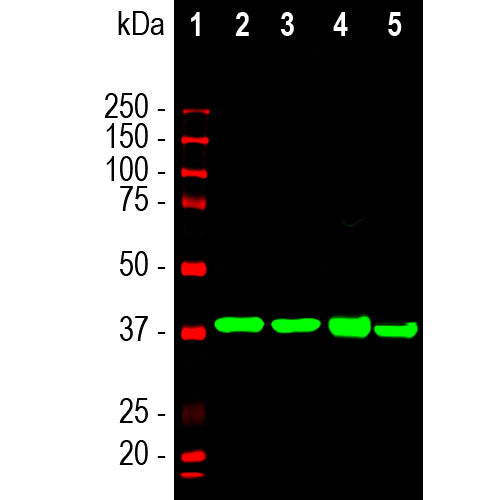

EnCor Biotechnology
Mouse Monoclonal Antibody to Aldolase C (ALDOC, ALDC, Zebrin II), Cat# MCA-4A9
Description
The MCA-4A9 antibody was made against a recombinant construct including the N-terminal peptide of human aldolase C. Later mapping studies localized the epitope to the peptide HSYPALSAEQKKELSDIA, amino acids 3-20. Since the three aldolase enzymes are quite similar in amino acid sequence many available antibodies to one protein have usually undocumented cross-reactivity with the other two. However we have used appropriate recombinant constructs to shown that MCA-4A9 is completely specific for aldolase C with no reactivity with either aldolase A or B. Since we know the identity of the peptide used to generate MCA-4A9 is firmly mapped to the N-terminus of aldolase C, a region in which there is considerable variability between the three aldolase enzymes. This antibody works well on western blots and for IF, ICC and IHC, and is a marker of some Purkinje cells and their dendrites and also certain non-neuronal cells. It corresponds to the protein Zebrin II, characterized by Brochu et al. (J. Comp. Neurol. 291:538-552 (1990). Zebrin II was characterized as an initially unknown antigen present in bands of Purkinje cells alternating with bands of Purkinjes which were Zebrin II negative. An alternative mouse antibody to aldolase C is MCA-1A1, which binds the N-terminal peptide of the human molecule, a region in which there is considerable variability between the three aldolase enzymes. A third EnCor mouse monoclonal antibody MCA-E9, binds a region in the center of aldolase c which is virtually identical in aldolase A and B, and consequently as would be expected binds all three proteins.
- Cell Type Marker
- Cytoplasmic Enzyme
- Epitope Mapped Antibodies
- Immunohistochemistry Verified
- Mouse Monoclonal Antibodies
Add a short description for this tabbed section
| Immunogen: | N-terminal sequence of human aldolase C MPHSYPALSAEQKKELSDIA |
| HGNC Name: | ALDOC |
| UniProt: | P09972 |
| Molecular Weight: | 40kDa |
| Host: | Mouse |
| Isotype: | IgG1 heavy, κ light |
| Species Cross-Reactivity: | Human, rat, mouse, cow, pig |
| RRID: | AB_2571880 |
| Format: | Protein G affinity purified antibody at 1mg/mL in 50% PBS, 50% glycerol plus 5mM NaN3 |
| Applications: | WB, IIF/ICC, IHC |
| Recommended Dilutions: | WB: 1:2,000. IF/ICC, and IHC: 1:1,000-1:2,000. |
| Storage: | Store at 4°C for short term, for longer term store at -20°C. Stable for 12 months from date of receipt. |
Aldolases are important glycolytic cytosolic enzymes which catalyse the reversible conversion of fructose-1,6-bisphosphate to glyceraldehyde 3-phosphate. There are three aldolase isozymes coded by three distinct genes in mammals, namely aldolases A, B, and C. Aldolase A is heavily expressed in muscle, and aldolase B is a liver-specific enzyme (1-5). In the adult, aldolase C is the brain-specific isozyme expressed in astrocytes and a few classes of neurons, notably Purkinje cells (4). Appropriate antibodies to aldolase C are therefore useful to identify astrocytes in cell culture and sections, and the enzyme may be over expressed in some forms of cancer (6). Recent studies also suggest that detection of aldolase C in blood may be a useful marker of the severity of traumatic brain injury (7).

Chromogenic immunostaining of a NBF fixed paraffin embedded human cerebellum section with mouse mAb to Aldolase C, MCA-4A9, dilution 1:2,000, detected with DAB (brown) using the Vector Labs ImmPRESS method and reagents with citrate buffer retrieval. Hematoxylin (blue) was used as the counterstain. The MCA-4A9 antibody strongly labels the cell bodies and dendrites of Purkinje cells. This antibody performs well in testing with both 4% PFA and standard NBF fixed tissues. Mouse select image for larger view.

Immunofluorescent analysis of cortical neuron-glial cell culture from E20 rat stained with mouse mAb to aldolase C, MCA-4A9, dilution 1:1,000 in green, and costained with chicken pAb to MAP2, CPCA-MAP2, dilution 1:10,000 in red. The blue is Hoechst staining of nuclear DNA. The aldolase C antibody labels cytosolic protein expressed in the glial cells, while the MAP2 antibody stains dendrites and perikarya of mature neurons. Mouse select image for larger view.
1. Popovici T, et al. Localization of aldolase C mRNA in brain cells. FEBS Lett. 268:189-193 (1990).
2. Weber A, et al. Dietary Control of Aldolase B and L-type Pyruvate Kinase RNAs in Rat. J. Biol. Chem. 259:1798-802 (1984).
3. Mukai T, et al. The structure of the brain-specific rat aldolase C gene and its regional expression. BBRC 174:1035-42 (1991).
4. Royds J, et al. Monoclonal antibody to aldolase C: a selective marker for Purkinje cells in the human cerebellum. Neuropathol. Appl. Neurobiol. 13:11-21 (1987).
5. Thompson R., Kynoch P. Willson V. Cellular localization of aldolase C subunits in human brain. Brain Res. 232:489-93 (1982).
6. Schapira F, Reuber M, Hatzfeld A. Resurgence of two fetal-type of aldolases (A and C) in some fast-growing hepatomas. BBRC 40:321-27 (1970).
7. Halford J, et al. New astroglial injury-defined biomarkers for neurotrauma assessment. J. Cereb. Blood Flow Metab. 37:3278-99 (2017).
Add a short description for this tabbed section





